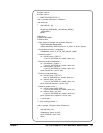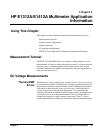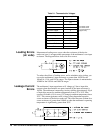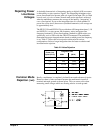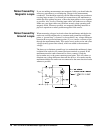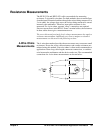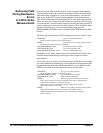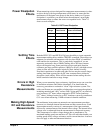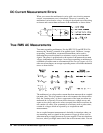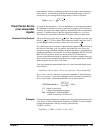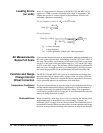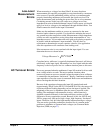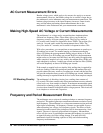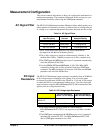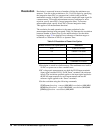
HP E1312A/E1412A Multimeter Application Information 31Chapter 2
Power Dissipation
Effects
When measuring resistors designed for temperature measurements (or other
resistive devices with large temperature coefficients), be aware that the
multimeter will dissipate some power in the device-under-test. If power
dissipation is a problem, you should select the multimeter’s next higher
measurement range to reduce the errors to acceptable levels. Table 2-3
shows several examples.
Settling Time
Effects
Both the HP E1312A and HP E1412A have the ability to insert automatic
measurement settling delays with the
TRIG:DEL command. These delays are
adequate for resistance measurements with less than 200pF of combined
cable and device capacitance. This is particularly important if you are
measuring resistances above 100k
Ω
. Settling due to RC time constant
effects can be quite long. Some precision resistors and multi-function
calibrators use large parallel capacitors (1000pF to 0.1
µ
F) with high resistor
values to filter out noise currents injected by their internal circuitry.
Non-ideal capacitances in cables and other devices may have much longer
settling times than expected just by RC time constants due to dielectric
absorption (soak) effects. Errors will be measured when settling after the
initial connection and after a range change.
Errors in High
Resistance
Measurements
When you are measuring large resistances, significant errors can occur due
to insulation resistance and surface cleanliness. You should take the
necessary precautions to maintain a “clean” high-resistance system. Test
cables and fixtures are susceptible to leakage due to moisture absorption in
insulating materials and “dirty” surface films. Nylon and PVC are relatively
poor insulators (10
9
ohms) when compared to PTFE Teflon insulators
(10
13
ohms). Leakage from nylon or PVC insulators can easily contribute a
0.1% error when measuring a 1MΩ resistance in humid conditions.
Making High-Speed
DC and Resistance
Measurements
The multimeter incorporates an automatic zero measurement procedure
(autozero) to eliminate internal thermal
EMF and bias current errors. Each
measurement actually consists of a measurement of the input terminals
followed by a measurement of the internal offset voltage. The internal offset
voltage error is subtracted from the measurement for improved accuracy.
This compensates for offset voltage changes due to temperature. For
maximum reading speed, turn autozero off. This will more than double your
reading speeds for dc voltage, resistance, and dc current functions. Autozero
does not apply to other measurement functions.
Table 2-3. DUT Power Dissipation
Range Test Current
DUT
Power at Full Scale
100Ω 1mA 100µW
1kΩ 1mA 1mW
10kΩ 100µA100µW
100kΩ 10µA10µW
1MΩ 5µA25µW
10MΩ 500nA 2.5µW



